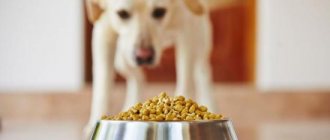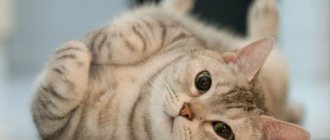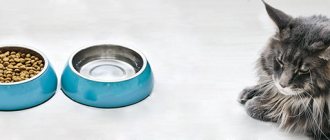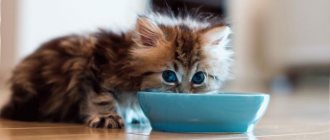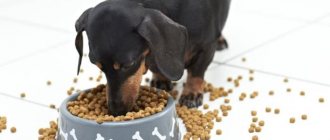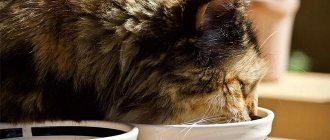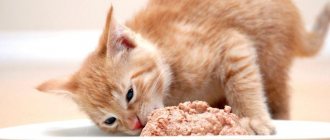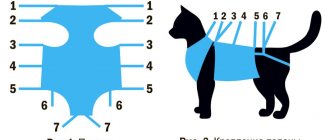The appearance of a kitten in the house is an incomparable joy, but at the same time a great responsibility. Ready-made dry food partially relieves the owner of the burden of caring for a new family member: there is no need to look for certain products, do complex calculations and convert percentages into grams - just pour the granules into a convenient bowl, and a balanced diet is ready.
But even with this feeding format, mistakes occur that, if repeated systematically, can damage the health of the animal. In this article we will look at how to feed a kitten dry food in order to raise a beautiful and healthy cat.
Can kittens eat dry food?
Today, pet store shelves are simply filled with a variety of foods. Here you can find options for every taste and budget. There is a separate line of dry food for kittens. At what age should this product be offered to furry children? How safe is it?
Many veterinarians claim that kittens should not be fed “dry” until they are 1.5–2 months old. The stomach of a cat child is simply not able to cope with such a load. Therefore, “crackers” can be given to a baby no earlier than three months of age.
There are other opinions regarding the age at which a kitten can start dry food. If you believe these experts, it turns out that you can give such food as soon as the baby learns to eat on its own. The argument is given that special food is being developed for small kittens. Firstly, it is very small. And secondly, it contains a large amount of useful substances. To get the same amount of “benefits” from natural food, the kitten will have to eat a lot. And this is simply physically impossible.
Therefore, whether you buy dry food for kittens, and at what age to do this, you will have to decide for yourself.
Rule #3. Practice Moderation
Each food package contains a table indicating feeding rates. When compiling it, developers of dry diets rely on the weight and activity level of the animal. A young and active cat needs more food than a couch potato of the same weight category.
The daily dose is usually divided into two equal parts and poured into a bowl twice a day - in the morning and in the evening. You should not expect the animal to eat the entire portion at once. It is absolutely normal if it comes to the bowl 10–12 times during the day, including at night. Some owners give the entire daily requirement at one time - this is completely acceptable and suitable for most cats.
But pouring food into the eye and allowing your pet to eat as much as it wants is absolutely not allowed. This can lead to obesity and related diseases. In order not to weigh the granules every time, it is convenient to use a measuring cup. You can make this simple device yourself. To do this you need:
- Take a plastic glass (or other small container).
- Measure the amount once on a kitchen scale.
- Record the level to which the feed is poured using a horizontal mark.
How to prepare a kitten's stomach
If you still decide that you cannot do without “crackers”, you will have to spend a little time on your pet. A kitten’s stomach at such a young age is simply not able to cope with such a load. Therefore, it needs to be trained.
Purchase special low-lactose milk for kittens at a specialty store and soak some dry baby food in it. If milk is not found, low-fat broth, kefir and just boiled water will do. Add some ground meat to the resulting mixture. Just a teaspoon is enough.
You don’t just need to add liquid to the food until you get “soup.” You need to wait until the pieces swell. Using a fork, grind the contents of the bowl into a homogeneous puree. A kitten's stomach is very delicate and the sharp edges of the granules can injure it.
Already closer to two months, the proportions of the mixture need to be changed. Add less liquid every week. Yes, and you can add a little more soft food, such as chicken pate.
The main thing is patience
How to properly switch a kitten to dry food depends on its previous diet. In any case, the transition should be gradual and carried out within two weeks. Some pets immediately pounce on the offered treat, while others need time to get used to it.
If the kitten has already appreciated the food from the table, in the first days of transfer you should add a few granules from the pack to the usual food. Slowly, day after day, the amount of ready-made food increases and completely replaces the previous diet.
It happens that the pet simply leaves the “drying” and eats its usual food. In this case, experienced breeders recommend slightly moistening the granules.
Kittens 3–5 months
At what age are kittens given dry food in its pure form? You should start doing this no earlier than the fluffy one is 3–3.5 months old. It is necessary to choose only dry food for kittens for complementary feeding. At what age you can give “crackers” of a particular brand is most often written on the packaging.
In order not to conduct experiments on the delicate cat's stomach, try to immediately determine what kind of food you are going to purchase later. It is with this brand that you start complementary feeding.
A kitten of this age is not yet able to independently determine the degree of saturation. Therefore, you should not exceed the feeding rates specified by the manufacturer. Be sure to have free access to clean drinking water.
At the age of six months, an older baby's teeth change. Therefore, “crackers” can be especially useful during this short time. Babies will chew hard, dry pieces, and temporary teeth will fall out faster.
Along with the granules, it is very useful for the kitten to give cottage cheese, boiled chicken and lean meat at this time. Note! “Together” does not mean “at the same time”! Each meal should contain one thing: either “crackers” or natural food.
Transition schemes
The basic principle when changing food is gradual replacement. For example, 10-15% of the old food is removed from the portion and this part is replaced with new food. On the second day, 20% is removed, on the third – 30%. So by day 7-10, the bowl contains 90% new and some old granules.
Difficulties arise when purchasing medicinal food. It may not be as tasty for your pet. Or when changing brands, as manufacturers use different ingredients and additives. In this case, it will take at least 2 weeks to accustom the cat to the new taste.
Second transition scheme by substitution method:
- The first 4 days 80% and 20% of old and new food, respectively.
- From 5 to 7 days – 60% to 40%.
- Day 8-10 – 40% old and 60% new.
- Days 11-13 – 20% old food and 80% new.
- Day 14 – 100% new food. In the following days, they feed only the new product.
All time frames are for reference only. The transition process may take a longer period, especially for finicky cats.
From six months to a year
Kittens between six months and one year of age are still growing. And it is no longer necessary for them to purchase special dry food for kittens. At what age should I switch to regular “adult” analogues? Not before all of the kitten's teeth are replaced. That is, at least from 6–7 months.
Teenage cats can be fed in the same way as adult cats. But until the animal is one year old, the diet should still contain more than just dry food. It is very important to feed your cat meat, fish, cottage cheese, vegetables and fruits. But giving whole milk is not recommended. This may result in an upset stomach.
Is it worth it at all?
The debate about what to feed a cat, dry food or natural food, has been going on for decades. When choosing the option that suits you, you need to consider:
- cat's food preferences;
- pet's health status;
- breeds;
- the degree of employment of the owners.
If your cat categorically refuses to eat crackers, but loves home-cooked food, you should meet her halfway.
There are few such individuals. Most cats, such as the Pixiebob breed, are happy to switch to drying. This feeding option is primarily convenient for owners who are busy at work. The finished product does not require time to prepare and does not spoil for a long time.
“Drying” is ideal for novice owners, since it does not require skills in preparing a complete cat diet. It contains all the vitamins and microelements the pet needs (with the exception of economy class food). The cat is not picky about eating vegetables, fruits, and herbs.
Eating “crackers” cats lose interest in natural food. They most likely will not pick up pieces on the street or eat mice or birds. This will significantly reduce the likelihood of poisoning.
Rules for feeding kittens
At what age are kittens given dry food? Reviews and opinions on this difficult issue are so diverse that you can’t imagine who to believe. If we assume that a conscientious manufacturer has put everything that is mentioned in the advertisement into the tin or bag of ready-made food, there is nothing terrible about “drying”. On the contrary, it’s incredibly convenient. But are you sure you should believe the advertising?
If you decide to feed your kitten “crackers”, pay attention to a few simple but mandatory rules.
Remember, either-or! This means that you cannot mix natural food and dry pieces. Never and under no circumstances! Store-bought food and food from a bag are digested differently. The stomach copes with the first on its own, but to digest the second, a large amount of liquid is needed. The kitten's stomach and intestines simply won't know how to work. As a result, you risk getting coprostasis or gastroenteritis. Before giving your kitten dry food, make sure that he ate “natural” food at least 3 hours ago.
Do not feed your animal mass market products. These are cheap foods that are sold in the nearest supermarket. This is equivalent to feeding your own child hot dogs and hamburgers all the time. Buy the highest quality food. Such food is unlikely to save your money, but it will protect your pet’s health from various diseases.
Don't experiment on your furry friend. Choose a brand of food once and for all. By mixing food from different brands, you will get an unimaginable “blend”. Using this method of feeding, you risk introducing an imbalance into the animal’s body. Exceeding the norm of calcium or, for example, amino acids will not bring anything good to your pet.
Summing up
If we feed a cat with different dry foods, we must clearly understand why we are doing this and what we are risking. In most cases, this practice has no rational basis and harms the animals in the long run. The exception is mixing feed as a temporary measure at the stage of accustoming to a new brand.
Feeding products of the same line, but with different tastes, is acceptable if it is well tolerated by the cat. But there is no particular need for this, since good dry food already provides a sufficient variety of ingredients.
How to choose dry food for a “cat-baby”
There is only one option when you can feed your kitten dry food. Products must be extra-premium. If you think that feeding your pussy “crackers” is cheap and not particularly troublesome, you are mistaken. Good food is very expensive. Even if you buy turkey meat that is not too budget-friendly to feed your animal, it will still be cheaper.
To determine the quality of purchased food, look at the label. The first five ingredients listed must be natural products. Even foods such as the well-known Royal Canin are not preferred. Of course, there will be no harm from them. But your kitten will not receive adequate nutrition.
There is an opinion that feeding a kitten with natural products takes too much time. This is completely wrong. It may indeed be difficult for you at first. But by the end of the first month, everything will definitely improve and providing proper nutrition to your pet will no longer take so much time.
Have you decided to focus on bagged food? Try these:
- Hill's Science Plan Puppy & Kitten.
- Orijen Cat-Kitten Formula.
- Eukanuba Puppy & Junior Small Breed.
- Chicken Soup Kitten Formula.
- Royal Canin Size nutrition Mini Junior.
Most of the ingredients in these foods are truly natural. Your kitten will receive all the necessary minerals and vitamins.
There is also a list of “crackers” that should never be fed to kittens. Undesirable trademarks include:
- Whiskas.
- "Katinka".
- "KitiKat."
- "Friscas" and some others.
The desire to improve low-quality food at the expense of more expensive food
A popular motive that encourages owners to mix two or more types of ready-made food. In order to save money, cheap food, usually based on cereals, is supplemented with more expensive food with a high meat content. It is assumed that the disadvantages of the first will be compensated by the advantages of the second. Unfortunately, in practice this scheme hardly works.
Firstly, each complete food has its own balanced formula, with a unique composition and ratio of components. Two ingredients that are individually beneficial and recommended for cats may be less digestible in the presence of each other. The consequences are unpredictable - from mild gastrointestinal disorders to serious deficiencies and malfunctions of the body.
Secondly, a diet high in grains itself provokes various diseases in cats: diabetes, urolithiasis (KD), individual food intolerance and other problems.
Finally, there is little point in such a practice. An animal needs more food with a high content of grains to get enough food than a diet based on meat components. We wrote more about this in the article: “How much food does a cat need per month?”
Thus, savings are often illusory. Moreover, when mixed, the beneficial components of expensive food may be less absorbed due to the fact that the “empty” food passes through the gastrointestinal tract at an accelerated rate. As a result, the owner remains even in the red, since he spent in vain on a premium product. Not to mention the high veterinary bills that can come with improper feeding.
Acana
This food belongs to the super-premium class. An excellent, fully balanced diet for your pet. The granules contain meat components, fresh chicken eggs, algae, fruits, vegetables, proteins, polyunsaturated fats and proteins.
Pros:
- complete rejection of various dyes and harmful additives;
- no grain or corn;
- balanced diet.
Minuses:
- not too wide variety of flavor options (chicken, lamb, fish);
- There are no prophylactic formulations in the line.
Feed requirements
When choosing a new type of food for your domestic cat, you must adhere to the following requirements:
- composition and calorie content. The composition of new food products should include all micro- and macroelements, as well as vitamins that an animal of a particular age needs for growth and development;
- manufacturer. It is better to give preference only to well-known and time-tested manufacturers;
- shelf life;
- price. The owner should be able to purchase a new food format.
The cat is getting old
At the moment there is no exact age by which we can say that a cat is old. All her life she develops and grows. Only closer to 8 years does the animal’s metabolism slow down. At this age, a cat needs a different diet.
According to the pattern, if a cat was not obese until the age of 8 and had no problems with being overweight, then in old age there should also be no such problems.
The most important problem for older cats, and pets in general, is poor digestibility of food. Fats are not broken down enough and enter the body.
You should choose a nutritious and at the same time light food for your pet. This food should contain amino acids, mineral supplements, and vitamins for older cats.
From kitten to adult cat
Kittens grow up so quickly that sometimes we don't notice it. A cute kitten grows into a stately cat. Kittens need food rich in vitamins and microelements for proper growth. Calcium is needed for bone growth, and B vitamins are needed for fur growth. Also, such foods are high in calories, which is not entirely suitable for an adult cat. Due to an overabundance of additives in the food, the cat may feel unwell and quickly begin to gain excess weight. To prevent this from happening, you should take care of changing the food in advance.
Kitten food is not suitable for cats over 1 year of age
The period after castration or sterilization
After this procedure, most cats begin to overeat. This reaction is associated with less activity, since before this they had to look for a partner.
Naturally, castration or sterilization itself does not affect weight gain. Incorrectly selected food has an effect.
Try to start switching your pet to special food immediately after the procedure. Add a little to regular food, special food, gradually removing regular food from the mixture. In specialized foods, the amount of fat is reduced, which will have a beneficial effect on the pet’s health.
The cat is sick
Pets, just like people, suffer from serious illnesses. Some diseases accompany the pet throughout its life. Diseases such as diabetes, pancreatitis, and kidney failure require constant attention. For such animals it is very important to eat properly.
Consult your veterinarian. He will select food that will help your pet live a full, healthy life.
